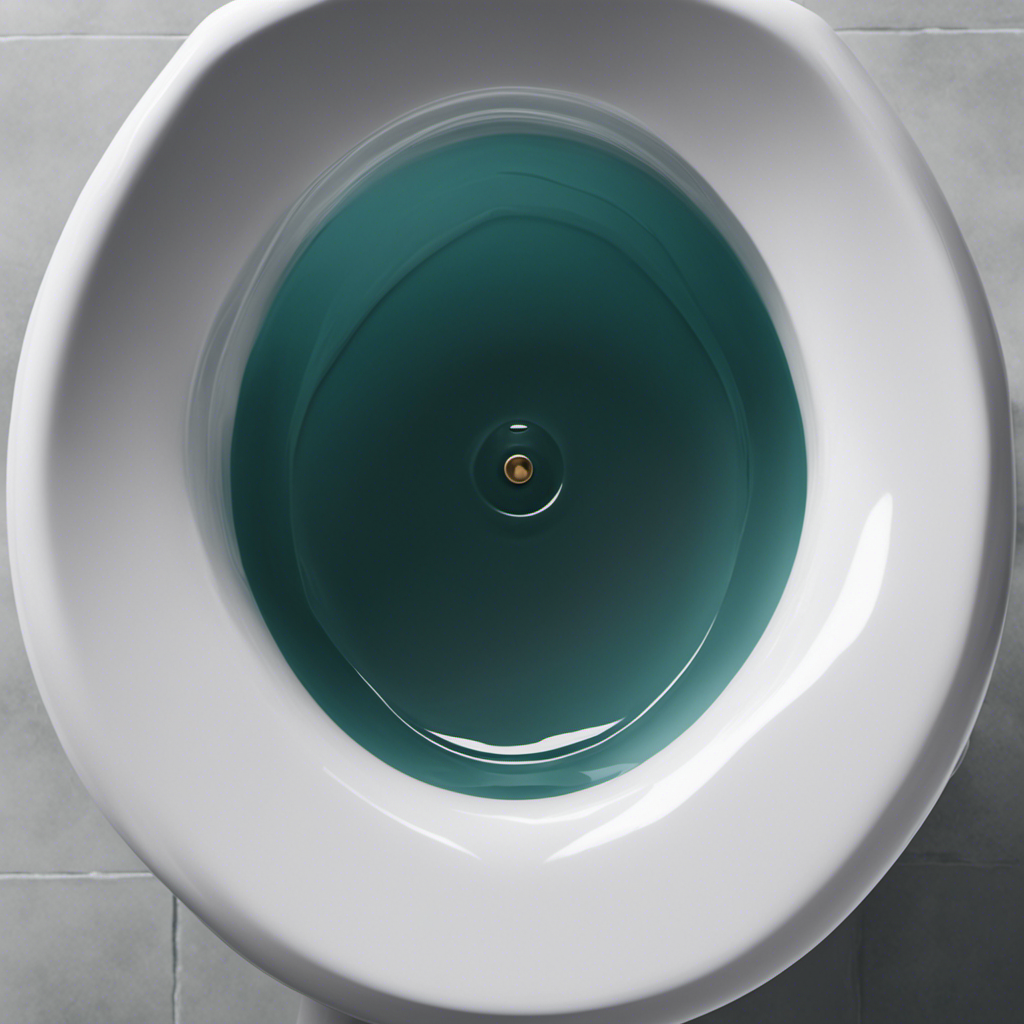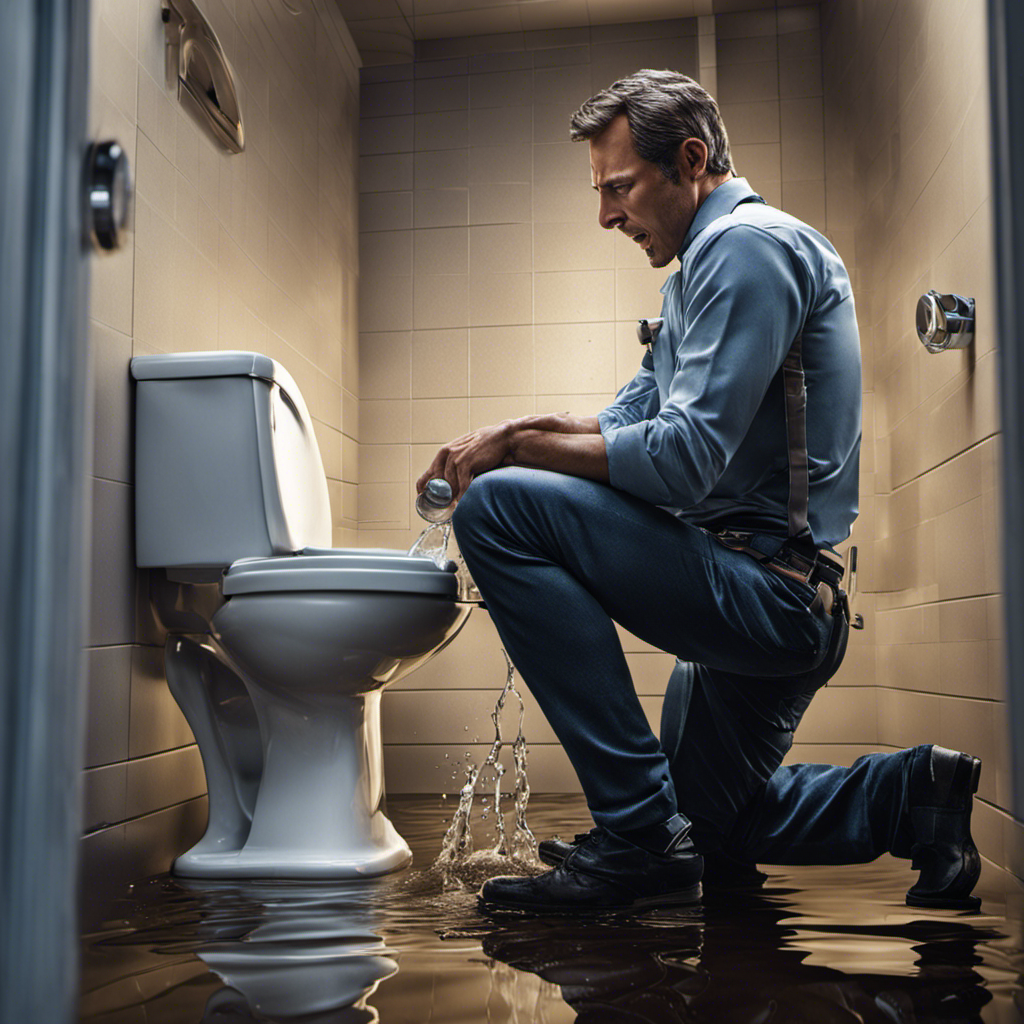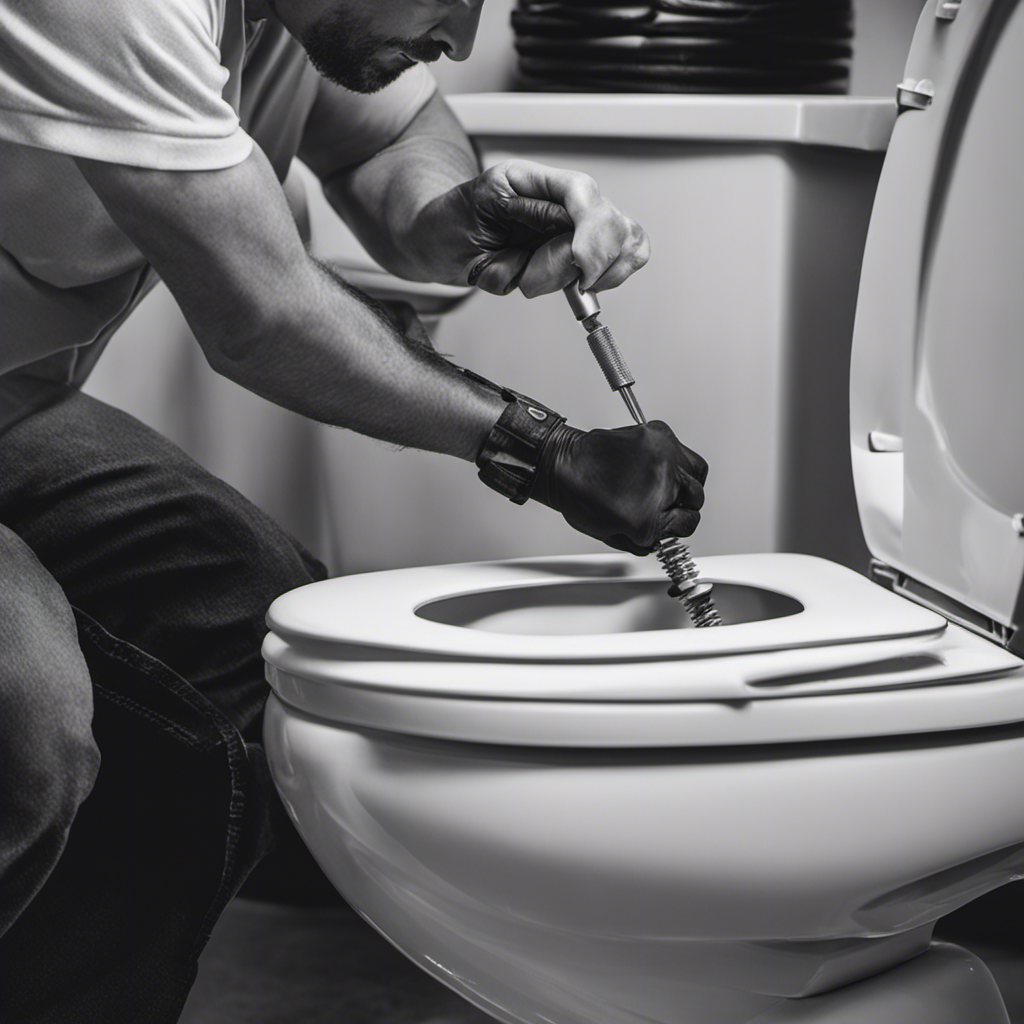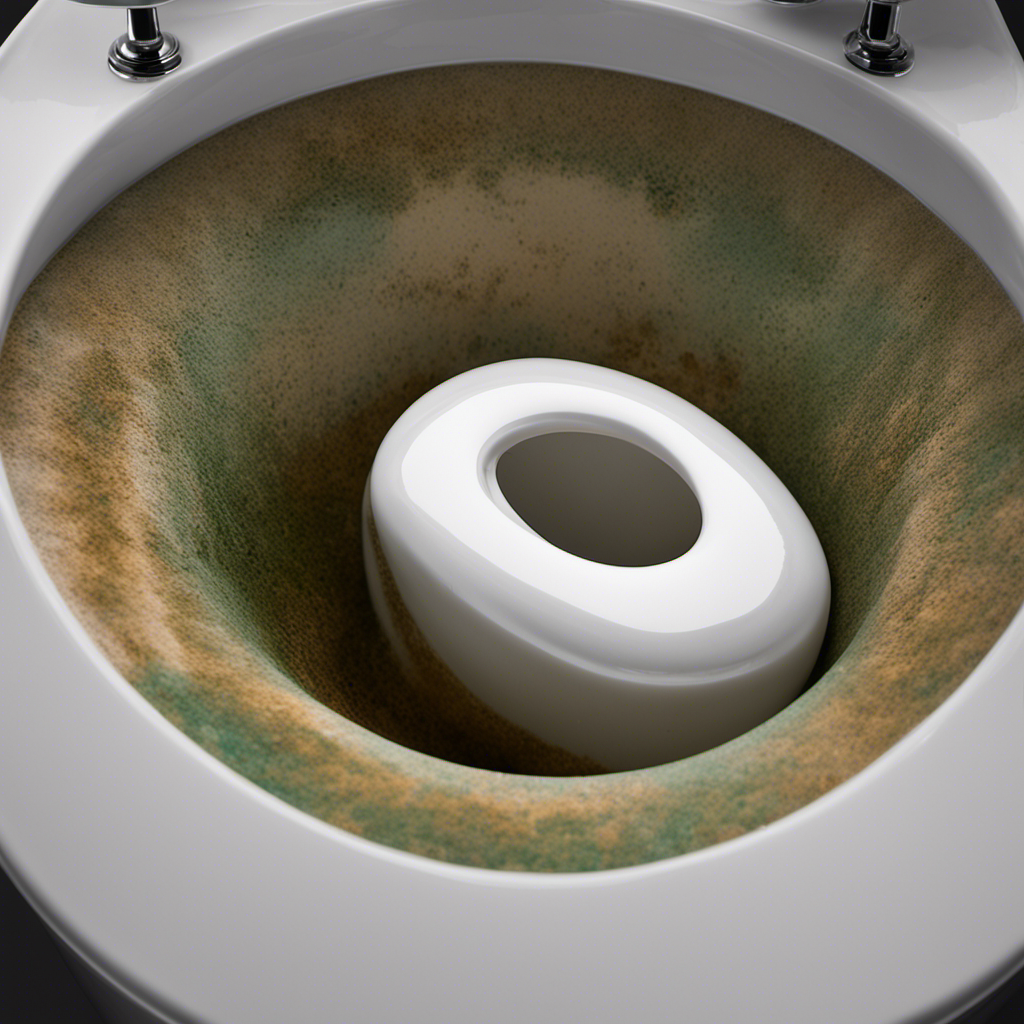Why would a toilet leak from the bottom? It’s a question that many homeowners have asked themselves, and one that I am here to answer.
In this article, I will delve into the common causes of toilet leaks from the bottom, providing you with the knowledge and understanding to tackle this issue head-on.
From faulty wax rings to cracked toilet bowls, I will explore the technicalities behind these pesky leaks and offer solutions to ensure a leak-free bathroom experience.
So, let’s dive in and uncover the mysteries of toilet leakage!
Key Takeaways
- Worn-out wax ring between toilet flange and base is a common cause of toilet leaks from the bottom.
- Cracked toilet bowl can also lead to leaks, and it should be handled with care during installation.
- Loose or damaged bolts securing the toilet to the floor can result in a faulty seal, and they should be tightened or replaced if necessary.
- Corrosion in the flush valve can cause leaks, and regular inspection and replacement of corroded parts is important.
Common Causes of Toilet Leaks From the Bottom
One common cause of toilet leaks from the bottom is a worn-out wax ring that needs to be replaced. The wax ring is located between the toilet flange and the base of the toilet, creating a watertight seal. Over time, the wax ring can deteriorate, causing leaks at the base of the toilet.
Another possible cause of leaks is a faulty toilet flapper. The flapper is responsible for controlling the flow of water from the tank into the bowl. If the flapper is worn or not sealing properly, water can leak from the bottom of the toilet.
It is also important to check the water supply line for any leaks or loose connections. Regular maintenance and timely replacement of these components can help prevent toilet leaks from the bottom.
Faulty Wax Ring: A Primary Culprit for Toilet Leaks
The faulty wax ring is often the primary culprit for toilet leaks. This crucial component seals the connection between the toilet base and the sewer pipe, preventing water from leaking out. Over time, the wax ring can deteriorate or become damaged, leading to leaks.
One of the most common signs of a faulty wax ring is water pooling around the base of the toilet. You may also notice a foul odor coming from the bathroom. To fix this issue, it is necessary to replace the wax ring. This can be done by removing the toilet, scraping off the old wax, and installing a new ring.
By addressing a faulty wax ring promptly, you can prevent further damage and avoid potential water damage to your bathroom floor.
Now, let’s explore another hidden source of leakage: the cracked toilet bowl.
Cracked Toilet Bowl: A Hidden Source of Leakage
If you notice water pooling around the base of your toilet and a foul odor in the bathroom, it could be due to a cracked toilet bowl.
Cracks in the toilet bowl can occur due to various reasons, such as age, improper installation, or excessive force applied to the bowl.
To prevent a cracked toilet bowl, it is important to handle it with care during installation and avoid placing heavy objects on top of it.
Regularly inspecting the toilet bowl for any signs of cracks, such as visible lines or leaks, can help identify and address the issue before it worsens.
Additionally, avoiding using excessive force when sitting or standing on the toilet can also prevent cracks from forming.
Proper maintenance and timely repairs are crucial in ensuring the longevity and functionality of your toilet bowl.
Loose or Damaged Bolts: A Potential Cause of Toilet Leaks
When you notice water pooling around the base of your toilet and a foul odor in the bathroom, it could be due to loose or damaged bolts. Loose or damaged bolts can lead to a faulty seal between the toilet and the floor, resulting in leaks. This is a common issue that can be easily resolved with a few simple steps. First, check the bolts that secure the toilet to the floor. If they are loose, tighten them using a wrench. If the bolts are damaged or corroded, replace them with new ones. Additionally, check the flange, which is the pipe fitting that connects the toilet to the sewage system. A damaged flange can also cause leaks and may need to be replaced. It’s important to note that improper installation is a common reason for toilet leaks. Make sure to follow the manufacturer’s instructions carefully when installing a toilet to prevent any future issues.
| Possible Cause of Toilet Leaks | Symptoms | Solution |
|---|---|---|
| Damaged Flange | Water pooling around the base of the toilet, foul odor in the bathroom | Replace the damaged flange |
| Improper Installation | Water leaking from the base of the toilet, unstable toilet | Reinstall the toilet following manufacturer’s instructions |
Corroded Flush Valve: A Troublesome Contributor to Leaks
I’ve come across another common cause of toilet leaks that can be quite troublesome: corrosion in the flush valve.
Over time, the constant exposure to water and minerals can cause the metal parts of the flush valve to corrode, leading to leaks.
Fixing a leaky toilet caused by corrosion involves replacing the corroded parts, such as the flush valve or its components, with new ones to ensure a tight seal and prevent further leaks.
Corrosion Causing Toilet Leaks
Corrosion can cause a toilet to leak from the bottom. When exposed to water and other substances, the metal components of a toilet can corrode over time. One common area where corrosion occurs is around the bolts that secure the toilet to the floor. If these bolts become corroded, they may weaken and eventually fail, leading to a leak from the bottom of the toilet.
To detect a toilet leak, you can perform a simple dye test. Add a few drops of food coloring to the toilet tank and wait for a few minutes. If the water in the bowl changes color, it indicates a leak.
To prevent toilet leaks caused by corrosion, it is important to regularly inspect the toilet’s components and replace any corroded parts promptly. Additionally, using a toilet tank cleaner regularly can help prevent the buildup of mineral deposits that can contribute to corrosion.
Fixing a Leaky Toilet
To fix a leaky toilet, you’ll need to first locate the source of the leak. Here are some steps to help you with toilet leak repairs and prevent future leaks:
-
Check the water supply line: Make sure the connection to the toilet tank is tight and not leaking. If there is a leak, tighten the connection or replace the supply line.
-
Inspect the tank components: Check the flapper valve, fill valve, and overflow tube for any signs of damage or wear. Replace any faulty parts to ensure a proper seal.
-
Examine the wax ring: The wax ring seals the toilet to the floor. If it is cracked or worn out, it can cause leaks. Replace the wax ring if necessary.
-
Tighten the bolts: The bolts that secure the toilet to the floor may become loose over time. Use a wrench to tighten them, but be careful not to overtighten and crack the toilet.
Plumbing Issues: External Factors Affecting Toilet Leakage
You might want to check if there’s any damage to the floor or the wax ring under the toilet. External factors can often contribute to toilet leaks from the bottom. These factors can include shifting of the flooring, corrosion of the wax ring, or even excessive pressure from the water supply. To prevent such leaks, it is important to address these external factors and take necessary precautions. Regularly inspect the floor around the toilet for any signs of damage or shifting. Additionally, ensure that the wax ring is in good condition and replace it if necessary. It is also advisable to monitor the water pressure and install a pressure regulator if the pressure is too high. By being proactive and addressing these external factors, you can prevent toilet leaks and avoid potential damage to your bathroom.
| External Factors | Prevention Tips |
|---|---|
| Shifting flooring | Regularly inspect the floor around the toilet |
| Corrosion of wax ring | Ensure the wax ring is in good condition and replace if necessary |
| Excessive water pressure | Monitor water pressure and install a pressure regulator if needed |
Frequently Asked Questions
How Can I Prevent Toilet Leaks From Happening in the First Place?
To prevent toilet leaks, I regularly inspect the connections and ensure they are tight. I also replace the wax ring every few years to maintain a proper seal. Additionally, I avoid flushing excessive amounts of toilet paper or foreign objects.
What Are Some Signs That Indicate My Toilet May Be Leaking From the Bottom?
When my toilet leaks from the bottom, it’s often due to a faulty wax ring or cracked toilet base. To fix it, I’d replace the wax ring or call a plumber for repairs.
Can a Cracked Toilet Bowl Be Repaired, or Does It Need to Be Replaced?
A cracked toilet bowl cannot be repaired and needs to be replaced. When faced with this issue, it is important to explore toilet bowl replacement options to ensure a proper fix and prevent further leaks.
How Do I Know if the Wax Ring on My Toilet Is Faulty?
When it comes to signs of toilet wax ring damage, there are a few things to look out for. If you notice water pooling around the base of the toilet, it could be a sign of a faulty wax ring. To replace it, you’ll need to remove the toilet, scrape off the old wax ring, and install a new one.
Are There Any Temporary Solutions to Fix a Leaking Toilet Before Calling a Plumber?
Temporary fixes for a leaking toilet before calling a plumber include tightening the bolts, replacing the wax ring, or using a toilet repair kit. DIY solutions can provide a temporary solution, but it’s best to consult a professional for a permanent fix.
Conclusion
In conclusion, toilet leaks from the bottom can be caused by a variety of factors.
The faulty wax ring is often the primary culprit, but a cracked toilet bowl, loose or damaged bolts, and a corroded flush valve can also contribute to the problem.
It’s important to address these issues promptly to prevent further damage and avoid potential plumbing issues.
By understanding the common causes of toilet leaks, you can take the necessary steps to fix the problem and ensure a leak-free bathroom experience.










